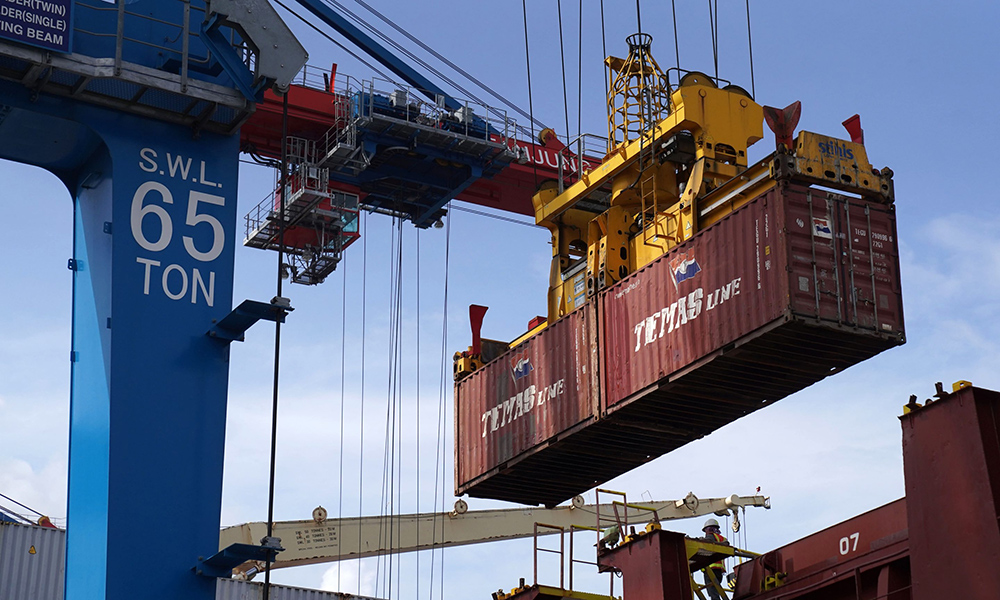
終于,美國的供應短缺和送貨延遲現象開始有所緩解,但大部分美國人對船運公司和聯邦政府的指責愈演愈烈,抱怨他們無能,讓消費者買不到想買的東西。
美國Morning Consult公司在11月對2200名消費者進行了一項調查。12月16日,調查結果公布,約58%的受調查者認為,運輸和物流公司對目前供應鏈瓶頸導致的供應短缺應該承擔“主要”或“部分”責任;而認為這一后果應該歸咎于政府的受調者占比達55%,二者比例差不多。

實際上,供應鏈是一個十分復雜的系統,而且大部分情況下都具有全球性。因此,一旦供應鏈出現問題,僅一方犯錯的情況是非常罕見的。今年,為解決供應鏈問題,喬·拜登政府已經采取了幾項措施,包括保持港口全天候開放、與商界領袖會談,甚至建議用國民警衛隊進行卡車運輸(白宮后來表示,目前尚未積極落實最后這項措施)。
專家表示,新冠疫情的影響還未完全消失,而消費者被壓抑的購物欲望和需求已經釋放,產生了一場完美風暴,因而給當前的供應鏈帶來了各種挑戰。美國外交關系委員會(Council on Foreign Relations)的著名研究員邁克爾·斯賓塞寫道:“盡管消費需求增加了,但新冠疫情仍然對主要港口和制造商存在影響,使其運作緩慢,拉低了供應效率。”
在新冠疫情期間,許多美國人瘋狂購買電子產品、家庭健身器材和樂器。隨后新冠疫苗面世,消費勢頭更是未見減緩。
與此同時,供應鏈上的許多行業,例如制造業、船運、交通運輸,甚至零售業,都仍然處于新冠疫情陰影的籠罩之下,紛紛出現工人短缺、交貨延誤和成本飆升等問題。
制造商不得不提高產量以滿足市場需求,但又給負責原材料運輸的公司帶來了壓力。與此同時,船運集裝箱開始出現短缺,成品堆積如山,運輸成本飆升。美國外交關系委員會的數據顯示,今年9月,從中國運送一個集裝箱到美國,運費高達2萬美元。而2020年2月,只需1500美元。
歸根結底,消費性開支激增引發的多米諾骨牌效應,使整個供應鏈系統瘀滯不前。雖然新冠疫情的爆發是主要原因,但企業對精益庫存和即時庫存技術的依賴,也是原因之一:企業精簡庫存后,如果需求飆升或供應鏈出現問題,就可能出現供應短缺的情況。
更糟的是,在新冠疫情初期,一些航運公司預料到消費者對其業務的需求會下降,所以降低了航行頻次。還有,一些國家及其政府已經出臺了交通限制措施,來遏制新冠疫情的擴散,這也不利于制造業和航運的發展。
經濟學家嚴正指出,以上問題的持續存在,導致了美國通脹率的上升。根據最新的消費者價格指數,美國的消費品和服務價格在過去一年里上漲了6.8%。
盡管情況嚴峻,但未來也將聽到一些好消息。專家預測,直到明年年初,供應鏈瓶頸都將持續以某種形式存在。然而,情況可能會于明年下半年趨于平穩。法國信用保險公司裕利安怡(Euler Hermes)在上周的一份報告中表示,全球供應鏈中斷的情況將持續到2022年下半年。但該公司也預測,明年全球貿易將增長5.4%。
當然,由于奧密克戎變異毒株和其它未來可能出現的變異毒株,不確定因素依然存在。一些毒株可能還對新冠疫苗產生抗藥性。美聯儲(Federal Reserve)的主席杰羅姆·鮑威爾在12月15日說:“不確定因素非常多。然而其會對經濟產生何種影響,將取決于在多大程度上抑制需求,而非抑制供應。”
鮑威爾稱,研究表明,新冠疫苗和加強針可以有效防護目前的變異毒株,因此接種新冠疫苗的人越多,新冠疫情對經濟的影響就越低。然而,這并不意味著影響為零。他說:“德爾塔毒株減緩了用人招聘的速度,切實對全球供應鏈產生了影響,妨害其正常運轉。因此,奧密克戎毒株應該也會對經濟產生不良影響。然而在我看來,這種不良影響目前還未充分顯露。”(財富中文網)
譯者:Transn
終于,美國的供應短缺和送貨延遲現象開始有所緩解,但大部分美國人對船運公司和聯邦政府的指責愈演愈烈,抱怨他們無能,讓消費者買不到想買的東西。
美國Morning Consult公司在11月對2200名消費者進行了一項調查。12月16日,調查結果公布,約58%的受調查者認為,運輸和物流公司對目前供應鏈瓶頸導致的供應短缺應該承擔“主要”或“部分”責任;而認為這一后果應該歸咎于政府的受調者占比達55%,二者比例差不多。
實際上,供應鏈是一個十分復雜的系統,而且大部分情況下都具有全球性。因此,一旦供應鏈出現問題,僅一方犯錯的情況是非常罕見的。今年,為解決供應鏈問題,喬·拜登政府已經采取了幾項措施,包括保持港口全天候開放、與商界領袖會談,甚至建議用國民警衛隊進行卡車運輸(白宮后來表示,目前尚未積極落實最后這項措施)。
專家表示,新冠疫情的影響還未完全消失,而消費者被壓抑的購物欲望和需求已經釋放,產生了一場完美風暴,因而給當前的供應鏈帶來了各種挑戰。美國外交關系委員會(Council on Foreign Relations)的著名研究員邁克爾·斯賓塞寫道:“盡管消費需求增加了,但新冠疫情仍然對主要港口和制造商存在影響,使其運作緩慢,拉低了供應效率。”
在新冠疫情期間,許多美國人瘋狂購買電子產品、家庭健身器材和樂器。隨后新冠疫苗面世,消費勢頭更是未見減緩。
與此同時,供應鏈上的許多行業,例如制造業、船運、交通運輸,甚至零售業,都仍然處于新冠疫情陰影的籠罩之下,紛紛出現工人短缺、交貨延誤和成本飆升等問題。
制造商不得不提高產量以滿足市場需求,但又給負責原材料運輸的公司帶來了壓力。與此同時,船運集裝箱開始出現短缺,成品堆積如山,運輸成本飆升。美國外交關系委員會的數據顯示,今年9月,從中國運送一個集裝箱到美國,運費高達2萬美元。而2020年2月,只需1500美元。
歸根結底,消費性開支激增引發的多米諾骨牌效應,使整個供應鏈系統瘀滯不前。雖然新冠疫情的爆發是主要原因,但企業對精益庫存和即時庫存技術的依賴,也是原因之一:企業精簡庫存后,如果需求飆升或供應鏈出現問題,就可能出現供應短缺的情況。
更糟的是,在新冠疫情初期,一些航運公司預料到消費者對其業務的需求會下降,所以降低了航行頻次。還有,一些國家及其政府已經出臺了交通限制措施,來遏制新冠疫情的擴散,這也不利于制造業和航運的發展。
經濟學家嚴正指出,以上問題的持續存在,導致了美國通脹率的上升。根據最新的消費者價格指數,美國的消費品和服務價格在過去一年里上漲了6.8%。
盡管情況嚴峻,但未來也將聽到一些好消息。專家預測,直到明年年初,供應鏈瓶頸都將持續以某種形式存在。然而,情況可能會于明年下半年趨于平穩。法國信用保險公司裕利安怡(Euler Hermes)在上周的一份報告中表示,全球供應鏈中斷的情況將持續到2022年下半年。但該公司也預測,明年全球貿易將增長5.4%。
當然,由于奧密克戎變異毒株和其它未來可能出現的變異毒株,不確定因素依然存在。一些毒株可能還對新冠疫苗產生抗藥性。美聯儲(Federal Reserve)的主席杰羅姆·鮑威爾在12月15日說:“不確定因素非常多。然而其會對經濟產生何種影響,將取決于在多大程度上抑制需求,而非抑制供應。”
鮑威爾稱,研究表明,新冠疫苗和加強針可以有效防護目前的變異毒株,因此接種新冠疫苗的人越多,新冠疫情對經濟的影響就越低。然而,這并不意味著影響為零。他說:“德爾塔毒株減緩了用人招聘的速度,切實對全球供應鏈產生了影響,妨害其正常運轉。因此,奧密克戎毒株應該也會對經濟產生不良影響。然而在我看來,這種不良影響目前還未充分顯露。”(財富中文網)
譯者:Transn
Product shortages and delivery delays are finally easing up, but many Americans increasingly blame shipping companies and the federal government for their inability to get their hands on the products they want.
About 58% of consumers say shipping and logistics companies bear “a lot” or “some” of the blame for the current supply chain bottlenecks that have led to shortages, according to Morning Consult’s survey of 2,200 consumers fielded in November and published on December 16. But nearly as many Americans, 55%, blame the government.
In fact, supply chains are complex and, in many cases, are global—which means there’s rarely one entity to blame when things go wrong. The Joe Biden administration has taken several steps this year to help fix supply chain problems, including keeping ports open 24/7, meeting with business leaders, and even supporting a National Guard deployment to reduce trucking shortages (the White House later said it wasn’t actively pursuing this option at the moment).
Experts say that the current supply chain challenges are a result of a perfect storm of pent-up consumer demand being unleashed before the effects of the pandemic had truly passed. “As demand increased, pandemic-related disruptions continued to affect major ports and manufacturing facilities, dampening the supply response,” writes Michael Spence, a distinguished fellow with the Council on Foreign Relations.
During the pandemic, many Americans went on a shopping spree for electronics, home workout gear, and musical instruments. And they have continued their spending after vaccines became available.
Meanwhile, many industries along the supply chain—manufacturing, shipping, transportation, and even retail—were dealing with COVID outbreaks, worker shortages, delays, and soaring costs.
Manufacturers eventually ramped up production to meet demand, but that put pressure on companies responsible for transporting raw materials. At the same time, shipping containers became scarce, and finished products piled up. And then transportation costs soared. Shipping a container from China to the U.S., for instance, hit $20,000 in September, compared with just $1,500 in February 2020, according to the Council on Foreign Relations.
Bottom line, the spike in consumer spending created a domino effect that clogged the system. While the pandemic played a significant role, corporations’ reliance on lean and just-in-time inventory techniques to limit their costs likely also played a part. These approaches mean companies store less inventory, which can lead to supply shortages if demand soars or if there are supply chain issues.
It also didn’t help that some shipping companies, at the beginning of the pandemic, reduced their schedules, anticipating a drop in consumer demand. Or that some countries and governments have put restrictions in place to contain COVID-19 outbreaks that also impact manufacturing and shipping.
Economists have blamed these ongoing issues as contributing to rising U.S. inflation rates. The price of U.S. consumer goods and services rose 6.8% over the past year, according to the latest consumer price index.
But there is some good news ahead. Experts predict that supply chain constraints will continue in some form or another through early next year, but likely level off during the second half. In a report last week, credit insurance company Euler Hermes said global supply chain disruptions will remain high until the second half of 2022, but it expects global trade to grow 5.4% next year.
There is, of course, uncertainty about the impact of Omicron and any future COVID-19 variants, some of which are expected to be vaccine-resistant. “There’s a lot of uncertainty,” Fed Chair Jerome Powell said on December 15. “What’s going to be the effect on the economy? That will depend on how much it suppresses demand as opposed to suppressing supply.”
Currently, research shows that vaccines and boosters work against the current COVID variants, so the more people who get vaccinated, the lower the economic effect, Powell said. But this doesn’t mean there won’t be any economic repercussions. “Delta had an effect of slowing down hiring, and it actually had an effect on global supply chains. And that hurt the process of the global supply chains getting worked out. So [Omicron] can have an economic effect. I just think at this point, we don’t know much,” Powell said.






